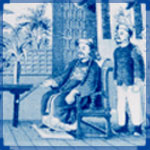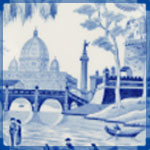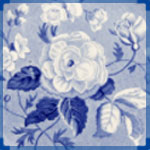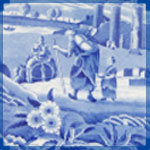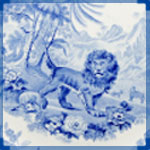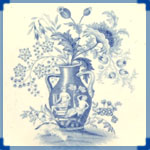- History
- Pottery
- Industry
PatternsDesignsIn 1784, Spode began printing under the glaze in blue on earthenware. Early patterns were either copied from or highly influenced by Chinese porcelain imports. Robert Copeland attributes the Chinese influence in the development of early patterns to two factors: Requests of London customers for replacements for their Chinese wares, and the arrival of the engraver Thomas Lucas who brought with him the knowledge of designs from his previous employer, Thomas Turner at Caughley. Many of the early blue transfer-printed patterns, grouped in this exhibition as Chinoiserie, were Chinese in style. As Spode's production advanced and its customers' tastes evolved, the variety of patterns grew. Interest in Chinoiserie patterns later gave way to patterns that depicted rural scenes, exotic places, literary themes, as well as floral and botanical examples. If a pattern included in this exhibit is also documented in Spode, Transfer Printed Ware, 1784-1833, by David Drakard and Paul Holdway, the Drakard/Holdway pattern number is referenced and the patterns appear in the same order as do Drakard/Holdway "P", or pattern numbers. Patterns included in the exhibit that are not documented in the Drakard Holdway book follow sequentially. The order in which patterns appear and are numbered in this exhibit is not necessarily the order in which Spode would have produced them. ColorsBy 1822, Spode had developed other colors, in addition to blue, that could withstand high-temperature glost firing. The production of these additional hot-press printed colors enabled Spode to expand its line of wares and, thus, grow market share. While not nearly as popular as Spode's various blues, these new colors included green, brown, manganese purple, Payne's grey, and black. Soon afterwards, in 1824, two-color underglaze printing began. Spode also employed other methods to add color. One method was to transfer print outline patterns and then paint in or between the lines of the pattern in other colors. Other methods included enameling with additional colors and gilded decoration over the glaze to further expand the variety of their offerings. Near the end of the early Spode period, pink was also put into production. ShapesSpode produced a wide variety of ceramic shapes for everyday use that were decorated with underglaze printing. The shapes included in this exhibition are organized in the same manner as they are found in Spode, Transfer Printed Ware, 1784-1833, by David Drakard and Paul Holdway: Dinner and dessert wares, wares for breakfast and tea, toilet and personal hygiene, and useful, ornamental and toys. |
CategoriesThe patterns featured in this exhibition are organized in the following categories: |

